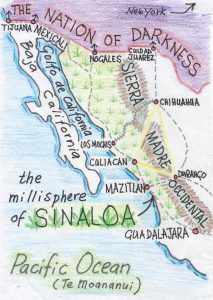 The Mexican state of Sinaloa (2.9 million) is too small to qualify as a millisphere but combined with the state of Sonora (also 2.9 million) we have a millisphere stretching from the US border in the north to Guadalajara in the south. I call this millisphere “Sinaloa” because both states are “controlled” by the Sinaloa drug cartel.
The Mexican state of Sinaloa (2.9 million) is too small to qualify as a millisphere but combined with the state of Sonora (also 2.9 million) we have a millisphere stretching from the US border in the north to Guadalajara in the south. I call this millisphere “Sinaloa” because both states are “controlled” by the Sinaloa drug cartel.
Sinaloa’s colonisation by Spain in the 16th century transformed the landscape. Concerned about Cortez and his conquistadors turning Mexico into their own domain King Charles sent his personal bodyguard, Nuno de Guzman, to establish control for the Spanish crown.
On horseback, de Guzman’s forces headed northwest into unclaimed territory, following Indian walking trails from village to village, slaughtering and enslaving and capturing corn supplies. Slaves were used to open the walking trails though the thorny scrub to accommodate a man on a horse and we have the route the highway follows today.
Proving to be truly psychotic in his attempt to outdo Cortez de Guzman was eventually sent back to Spain in chains, leaving behind an almost deserted millisphere. When gold and silver were discovered in the Sierras, Amerindian and African slaves and poor Spaniards were brought in, and their descendants populate the Sinaloa millisphere today.
Last week the former “head” of the Sinaloa Cartel, Joaquin Guzman, aka El Chapo, was convicted in a New York Federal Court on firearms, drug trafficking and money laundering charges. Key witnesses to testify against El Chapo were Jesus Zambada and Vicente Zambada the brother and the son of “El Mayo” Zambada, who now heads the Sinaloa cartel – along with El Chapo’s sons.
El Chapo was born in Mexico’s “Triangulo Dorado” (Golden Triangle), in the mountains between Culiacan, Durango and Chihuahua, some time in the 1950s. Poverty in Mexico and the demand for cannabis in America meant El Chapo was growing marijuana from an early age.
By the 1960s the Sinaloa marijuana farmers had formed a growers’ collective and were developing stronger varieties of cannabis. The potent “sinsemilia” strain (Spanish for “without seed”) was developed in Sinaloa and much of the weed the hippies were smoking north of the border in the 1970s was being supplied by what became the Sinaloa Cartel.
El Chapo’s strength was “freight logistics”, and he had a network of tunnels dug across the US/Mexico border. The Columbians nicknamed him El Rapido for the speed he moved their cocaine into the American market and by the 1990s the Sinaloa cartel was fabulously wealthy – and El Chapo was in jail.
In 2001 he escaped from prison for the first time and he was on the loose somewhere in Sinaloa when my travel companion and I passed through. Mazatlan, where El Chapo was recaptured in 2014, was a laid back, heritage tourist town with a nice beach. Motorhome parks were filled with “snow birds” from as far north as Canada.
Los Mochis, where El Chapo was recaptured, again, in 2018, is where you catch the Chihuahua-Pacific that takes you through the scenic Copper Canyon (deeper and longer that the Grand Canyon).
At Los Mochis we slept in and missed the early “tourist” train. Trundeling northeast towards the Sierras, a bi-plane, trailing a plume of mist, came in low and sprayed our train, and a team of Mexicans picking tomatoes, probably for Los Angeles; vulchers settled on Saroya cacti in the sunset, and it was dark when we entered the canyon.
Since El Chapo’s recapture and extradition to New York, the volume of heroin crossing Mexico’s northern border into the USA has gone up by 40 percent and Fentanyl is up 100 percent. Since de-facto cannabis decriminalisation in many US states, Mexican marijuana exports have dropped by 40 percent.
Sitting in the Manhattan Metropolitan Correctional Centre, in New York, El Chapo now faces being transferred to the dreaded ADX, in Colorado, where 500 men are kept in permanent solitary confinement.
Fifteen tonnes of Columbian cocaine is worth 39 million in LA, 48 million in Chicago, and 78 million in New York, still the most lucrative market (Guzman trial evidence).
“The day I don’t exist [drugs] are not going to decrease in anyway at all,” Joaquin Archivaldo Guzman Loera, Rolling Stone interview, 2017.
